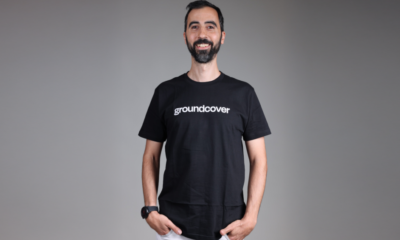Interviews
Brad Booth, CEO of NLM Photonics – Interview Series

Brad Booth is the CEO of NLM Photonics and a veteran in data center evolution, with leadership roles at Microsoft Azure, Meta, Dell, and Intel. A founder of the Consortium for On-Board Optics and contributor to IEEE Ethernet standards, he has long bridged customer needs, industry standards, and innovative solutions.
NLM Photonics develops hybrid organic electro-optic materials that cut AI data center network power use by up to 50%. Its Selerion-HTX platform delivers more bandwidth with less energy, enabling smaller, more efficient photonic circuits for sustainable, high-performance computing.
You’ve had quite the journey—from Meta, Azure, and Microsoft to founding the Consortium for OnBoard Optics, and now leading NLM Photonics. What personally motivates you to focus on improving data center energy use?
Most of my career has focused on communications and connectivity, from working on telephone handsets at Bell-Northern Research to working on network architectures at Microsoft and launching industry consortia like the Ethernet Alliance, Consortium for On-Board Optics, and Ultra Ethernet Consortium. I’ve seen firsthand how modern computing hinges on how we move data.
The rise of AI has brought immense capability but has also increased the volume of data being moved. Photonics has become critically important in today’s data centers and is having a growing impact on the percentage of energy used within those data centers. What motivates me is the opportunity to fundamentally shift the photonics industry’s trajectory to deliver better performance with less energy consumption. That’s what drew me to NLM Photonics. We’re not just improving a data center’s energy efficiency; we’re reshaping what’s possible at the material level to flatten the trajectory.
We heard that you and your wife live sustainably—raising livestock and collecting rainwater off the grid. How have those values shaped your leadership and the mission at NLM?
When my wife and I moved back to Austin, TX in 2007, we purchased a home on 2.5 acres that was 100% dependent on a rainwater collection system. It was the catalyst for us to pursue greater sustainability. We decided to have dairy goats, chickens, and guinea fowl as well as a greenhouse and garden, and I built the coop and goat shed to be completely off-grid with its own water collection system. We also built an addition to the house that achieved an Austin Energy 5-star rating. It was a great opportunity to learn about sustainability and how energy efficiency is measured. We have used what we’ve learned from that to try to incorporate that into wherever we live. It can be challenging, but it certainly brought about an awareness of how even one person can have an impact.
NLM’s new materials are said to cut network energy use by up to 50% and deliver much more bandwidth. Can you explain, in simple terms, how this technology works and why it’s such a breakthrough?
Traditional silicon photonics modulators rely on what is known as a carrier-depletion effect to change the phase or intensity of the light passing through the modulator’s waveguide. As data rates increase, the ability to modulate requires greater power but also results in signal quality degradation. Above 200 Gb/s, traditional silicon photonics are no longer considered viable due to signal quality and power requirements.
At NLM, we’ve developed a fundamentally different solution. We replace the silicon oxide in the waveguide with our organic electro-optic materials; this allows modulators to operate more efficiently and in a smaller footprint than silicon alone. That smaller footprint and the high electro-optic responsivity of NLM’s materials translates to higher bandwidth, lower drive voltages, and more photonic integrated circuits (PICs) per wafer, all while maintaining stability at temperatures above 120°C.
We’re not asking fabs to change their entire infrastructure. Our hybrid approach is a post-manufacturing step that does not disrupt standard manufacturing flows. Our 1.6T DR8 PIC manufactured at Advanced Micro Foundry (AMF) required no special tooling, and NLM performed the post-processing at our facility. Eventually, the post-processing NLM performs will be transferred to our partners to enable high-volume manufacturing. NLM’s goal is to enable future photonic devices to scale their performance without blowing through power budgets.
NLM works with a range of chip-making and hardware companies. Who are you collaborating with right now, and how are those relationships helping you scale?
We’re working with a great network of partners across the photonics and semiconductor ecosystem. Publicly, we’ve discussed our collaboration with AMF, Enosemi, and Centera on our 1.6T DR8 PIC, but we have also been collaborating with our investors and others in the industry. These collaborations help validate our technology through third parties in real-world systems and accelerate our path to scalable manufacturing. As we make progress with our partners, we plan to share more results with the industry.
AI data centers use a huge amount of energy—especially for networking. If NLM’s tech is widely adopted, what kind of real-world impact could it have?
If deployed at scale, our technology could cut network power use in AI data centers by up to 50%. That’s massive when you consider that photonics can account for 20-40% of a data center’s total power. In an AI data center, our technology could reduce overall data center power requirements by up to 15%.
As data center providers and hyperscalers look to scale and grow, whether or not to support AI, reducing the power consumption of the photonics in the data centers can permit them to expand capacity in existing facilities, slowing the need to build new facilities. It’s a path to sustainable growth at a time when energy has become the gating factor.
How does your technology fit into the next generation of hardware used in AI systems? Are you designing for existing equipment, or for new kinds of systems that are still emerging?
Both. NLM’s solutions fit into next-generation AI and data center hardware starting with 200Gb/s per wavelength and scaling to 400Gb/s per wavelength with our silicon organic hybrid (SOH) PICs. NLM has also provided technology for plasmonic organic hybrid (POH) PICs like those developed by Polariton Technologies. Those PICs have achieved record electro-optic responsivity for applications that require frequencies in the terahertz range. NLM is also working with a client in the quantum computing space, because our technology can be tuned for lower loss.
Do you see your technology being useful beyond AI—such as in future quantum computing or space-based communications?
Absolutely. We’ve already seen promising results in quantum applications with our quantum customer where our materials deliver clean, stable signals even at cryogenic temperatures. NLM’s solutions are well-suited for satellite and space-based systems where size, weight, and power are critical. NLM has had government grants with NASA and the Air Force (AFWERX) due to the benefits of our technology. The versatility of our technology opens many frontiers.
What’s next for your product line, Selerion? Are you working on versions tailored for specific industries like telecom or edge computing?
We just announced Selerion-BHX, designed specifically for ultra-high bandwidth and small form-factor applications like optical I/O and satellite communications. It delivers record-breaking modulation efficiency and opens the door for systems operating at 400Gbps and beyond. We have the ability to tailor our materials for specific verticals, from telecom to defense, because one size doesn’t fit all. We also have non-crosslinkable technology that we sell to research and academic institutions.
You’re working with researchers from universities like UW and ETH Zurich. What’s in the pipeline, and can you share any exciting developments we should watch for?
We’re building on decades of foundational work at the University of Washington, and our team has been collaborating with world-class labs and research institutions. Some of the most exciting developments involve new generations of our electro-optic materials that push even further on speed, stability, and power efficiency. We will gladly share more when we are able to disclose publicly.
You’ve helped shape important tech standards in the past. How important is it for new materials like yours to fit into global industry standards?
It’s critical. Adoption hinges on interoperability, and the industry needs to trust that new materials will fit into existing ecosystems. That’s why we focus on compatibility with standard silicon fabs and why we engage with standards bodies. Our goal is to make it easy for partners to adopt our technology without retooling their entire process.
What advice would you give to young engineers or startup founders who want to work on sustainable, high-impact technologies?
Don’t be afraid to challenge the status quo. Many breakthroughs come from revisiting assumptions—whether it’s about materials, systems, power, or scale. And remember: you don’t have to build everything yourself. Find good mentors and partners in the industry to help you navigate the challenges. Collaborate, iterate, and focus on solving real-world bottlenecks. The world needs technology that not only performs but also sustains.
Thank you for the great interview and for working on sustainability and data centers, readers who wish to learn more should visit NLM Photonics.












